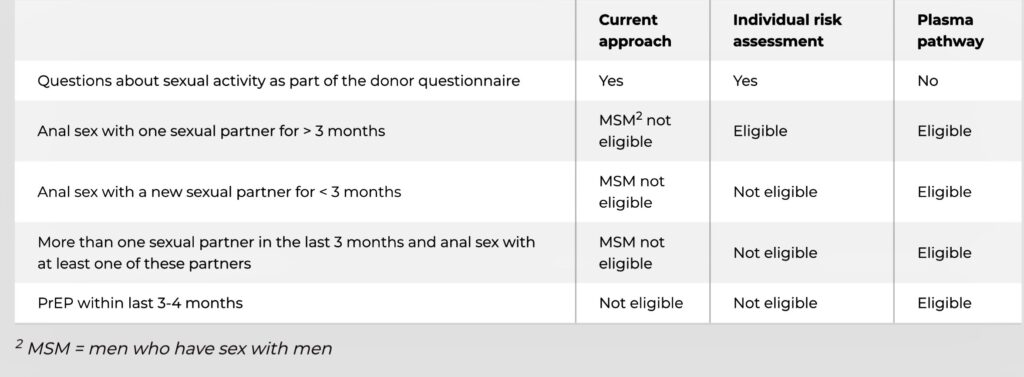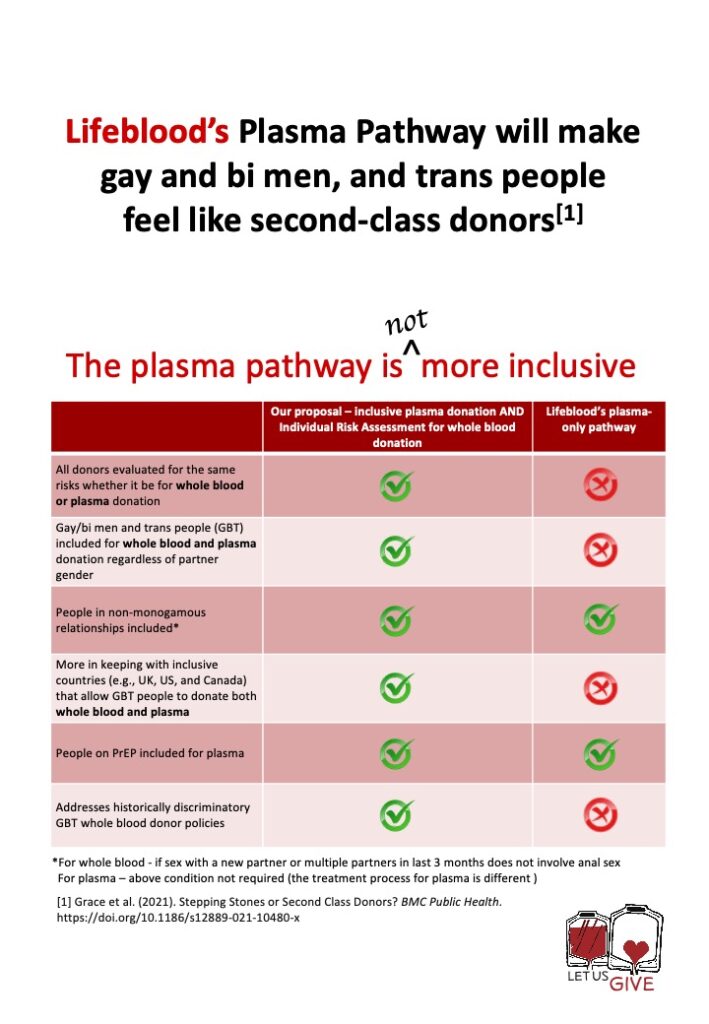

The Red Cross Lifeblood Service has begun a public relations campaign that attempts to redefine exclusion as inclusion.
It wants to convince the nation that its plan for allowing gay men to donate blood plasma but not whole blood is better than Canada and the UK’s approach which is to treat us equally for both whole blood and plasma donation.
Like many Australians, I respect the Red Cross for its decades of work helping Australians in need, including through its Lifeblood service.
That’s why my advice to the Red Cross is to pull back on its PR campaign before its reputation for impartiality is damaged.
Lifting The Gay Blood Ban
At the moment gay men, and bisexual men and trans women who have sex with men (GBT people), must be sexually abstinent for three months before donating blood.
More and more countries are abolishing this old ban and adopting a new system whereby all donors of whole blood, gay and straight, cis and trans, are asked the same questions.
This includes countries like the UK, the US, the Netherlands and Canada. In those countries all donors are asked if they have had anal sex with a new or multiple partners in the last three months. The focus is on activity that causes risk, not the gender of a donor’s sexual partner.
Australia should go down the same path. But the Red Cross Lifeblood Service has diverted us on to what it calls “the Plasma Pathway”.
The ‘Plasma Pathway’
Lifeblood’s proposal is to allow GBT people to donate blood plasma, not whole blood.
This is because plasma, unlike whole blood, can be heat treated for pathogens such as HIV.
Lifeblood hasn’t accepted individual risk assessment for whole blood donation because it believes this will reduce the blood supply by screening out women who have anal sex with new or multiple partners.
A Canadian study found the percentage of existing straight donors who would be deferred from donating because of using individual risk assessment questions would be less than 1 percent, a figure made up for by new gay donors.
But Lifeblood seems very concerned about losing those few at-risk straight donors, much more concerned than it has ever been about losing the 95 per cent of GBT people who are safe to donate.
It’s so concerned, that it is determined to sell its “Plasma Pathway” as the best way forward, when the truth is exactly the opposite.
How Lifeblood Is Misleading Us
Let’s consider the following Lifeblood table comparing the current ban, individual risk assessment and the Plasma Pathway.
At first glance it looks like Lifeblood’s proposed Plasma Pathway is the best option for those who can’t currently donate.
People on PrEP can donate under the Plasma Pathway, but not under individual risk assessment for whole blood.
It’s the same for people in new or multiple relationships.
But there’s two key facts missing.

The Discrimination Will Remain
The first is that under the Plasma Pathway GBT people can’t give whole blood.
The three-month sexual abstinence requirement that applies to us now will still apply.
This means GBT people who have rare blood types, and who could give blood during emergency situations or to relatives undergoing cancer treatment, won’t be able to help save lives.
It means we will be second class donors, able to donate plasma because it’s treated for pathogens, but still considered too disease-prone to be treated like other donors.
I didn’t invent the term “second-class donors”. It comes directly from a study Canadian researchers conducted when that country trialled plasma-only donation scheme.
If this is what Canadian gay men thought of the plasma-only option, I have no doubt Australians will too.
It Doesn’t Have To Be Either / Or
The other key fact missing from Lifeblood’s table is that plasma donation, and whole blood donation under an individual risk assessment scheme, are not mutually exclusive.
We can and should have both. The US, the UK, the Netherlands and Canada do, so why not Australia?
The germ of truth in Lifeblood’s PR is that its proposed plasma-only option has fewer restrictions than plasma donation in other countries: No sexual risk questions are asked and people on PrEP can donate.
This is splendid, but it’s not a reason to deny whole-blood donation.
Let Us Give wants Australia to allow GBT people to give whole blood without any discriminatory questions.
We also want to allow GBT people to give plasma under Lifeblood’s proposed plasma-donation regime, including those who can’t give whole blood.
It doesn’t have to be either/or. It should be “and”.
Inventing New Ways To Discriminate
Three other irritating pieces of misinformation should also be corrected.
In some of its communications, Lifeblood says donors must be monogamous to donate blood under individual risk assessment. That’s not true. They just can’t have anal sex with new or multiple partners in the last three months.
Lifeblood over-estimates the number of people on PrEP who would be potential new donors under its plasma-only proposal.
It says 60,000, but most of those can already donate plasma based on current PrEP-related criteria. Only those on PrEP in the last three months would normally be excluded, and that figure is only 24,000.
Lifeblood also says its plasma-only option is a world first. That’s misleading.
As noted above, Canada trialled plasma-only donation for GBT people. It quickly abandoned the trial and moved on to individual risk assessment for whole blood AND plasma donation instead. Israel did the same.
Obviously, all the other countries that allow whole blood donation by GBT people also allow plasma donation.
The main thing Australia is leading the world on is inventing new ways to be discriminatory in blood donation and to pretend that discrimination is a step forward.
That is shown clearly by this table put together by Let Us Give. It takes into account the facts Lifeblood omits from its table.

Moralistic And Judgy
Lifeblood’s communications strategy is clear.
It wants to demonise whole blood donation under an individual risk assessment scheme and legitimise its Plasma Pathway by making the former look discriminatory, exclusive, moralistic and judgy compared to the latter.
In fact, the truth is exactly the opposite. Lifeblood’s continued demand that GBT people be sexually abstinent for three months before giving whole blood is what is most discriminatory and judgy.
So is its demand that GBT people settle for plasma-only donation instead of being allowed to give whole blood.
We faced the same problem in the late 2000s when some politicians tried to sell us civil unions instead of marriage equality.
They said civil unions were cooler and more contemporary than marriage, and didn’t come with all the religious and patriarchal baggage of matrimony.
But when we said, let’s have both, and were told only civil unions were on offer, not marriage, it was clear all the business about baggage was just political spin.
It’s the same with the Plasma Pathway. It’s being misleadingly sold to us as less discriminatory, when it is just old-style discrimination in a new package.
Hopefully, Lifeblood will realise its spin won’t fool anyone and stop its PR campaign.
More than that, hopefully, it will abandon the plasma-only proposal altogether and move Australia forward to full equity in blood donation.
In the meantime, support the campaign to remove all discrimination in blood donation by signing the petition: https://www.change.org/p/let-us-give-blood-save-more-lives










Would Not Give Blood, Due to Red Cross owing all Melbourne Gay Men an apology.